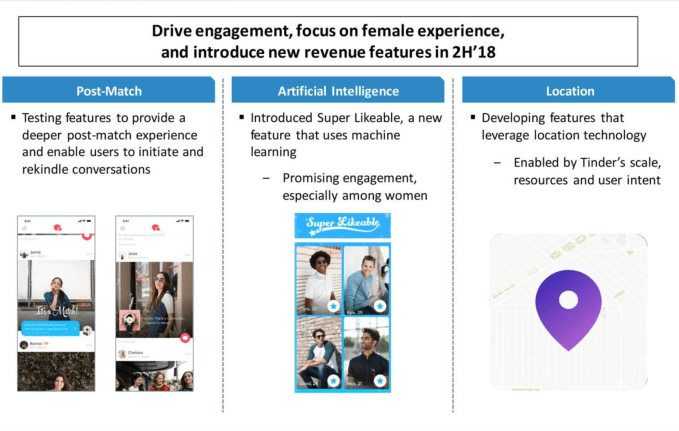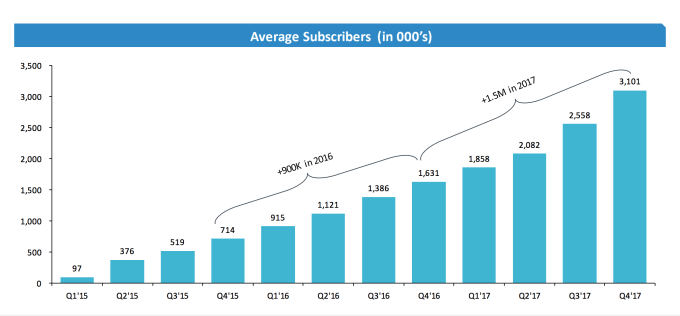Tinder will launch a series of new features based on location in 2018, its parent company Match Group revealed during this week’s Q4 2017 earnings. The dating app maker has been fairly vague on what these new features will entail, having only described them previously as something that will blur the “distinction between digital and real-life dating, and dating and simply engaging in your social life.”
This hints at further efforts at expanding Tinder into more of social network for young singles, rather than an app whose sole focus is on creating relationships.
Tinder has also said before that its plans around location had the potential to bring in “a new audience,” as they “expand the definition of dating.” That could imply the company is thinking about how Tinder could be used to simply help people make new connections, including those that may only turn into friendships, not dates.
The company has also said the location-based feature set will include releases where each new feature builds on top of the prior one, but hasn’t offered any details around how they will work.
While Tinder today lets you scout for matches by distance from you, or set your location to a different city through the paid feature, Tinder Passport, users have often requested enhancements like sorting matches by location or visualizing matches on an in-app map.
Alternately, other dating apps have leveraged users’ location for “missed connections” type features, as with the app Happn. Match Group’s own namesake app, Match.com, even rolled out its own take on missed connections back in January 2017.
In its case, the feature doesn’t show a user’s real-time location or precise last location, for privacy purposes. Instead, it shows users at intersections that are within one block of a past location. And other users can only view this location data for a few hours, for safety’s sake.
Tinder won’t say if it’s planning something similar, though it seems that some sort of toggle for temporarily sharing a live location may make sense for those who want to use the app when they’re out and about, and looking to meet people. This is something people already do in the app as something of a hack by setting their distance settings to under a mile – as surely Tinder knows.
There’s also definitely room for the app to better connect people who are on Tinder with the same goals. Tinder’s description of the new location features say they take “user intent” in mind, so potentially some ability to either display or filter out certain types of matches could come into play.

Tinder barely touched on its plans for the upcoming location-based feature set during the earnings call this week. After mentioning products it’s testing, such as the A.I.-powered Super Likable and those that aim to improve the post-match experience, Tinder confirmed a new, location-based feature set is in the works for 2018.
“We’re also actively developing a series of location-based features which we believe have the ability to meaningfully enhance the Tinder experience,” said Match Group CEO Mandy Ginsberg on the investor call. “Tinder has incredible scale given its viral growth and the dating context provides a level of intent that traditional social networks can’t capture. And overlaying location as a vector could be compelling, especially to a young, mobile and very social audience.”
Ginsberg added that Tinder is being intentionally vague about the new additions because it believes they’ll be a competitive advantage.
“But we didn’t want people to lose sight that it is a focus for us,” she added.
The features were also noted within the Q4 2017 slides, released alongside the earnings.

It does sound like whatever Tinder is building in this area will be free, as the company confirmed that it won’t be rolling out new monetization features until the second half of 2018. Tinder also pointed to the success of its premium product, Tinder Gold, as providing a revenue stream that allows it to develop more free features that make its app appealing to a wider audience.
Tinder today remains one of the biggest drivers of revenue for Match Group, accounting for around 30 percent of its parent company’s revenue in 2017.
The dating app added 1.5 million paid subscribers in 2017, up from about 900,000 in 2016. It now has more than 3 million paid subscribers in total, thanks to the addition of 544,000 in Q4 2017.
Match Group as a whole reported revenue of $378.9 million for the quarter, up from $295 million a year earlier. However, the company reported a net loss of $9 million for the quarter, or 3 cents a share, down from profit of $73.8 million a year ago. This was attributed to a charge of $92 million due to the U.S.’s new tax law. Had the law not been in place, net income would have been $83 million, or 29 cents per share.
